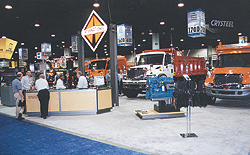"The last two-and-a-half years were terrible but now, the commercial truck industry is starting to trend upward," said Stephen Latin-Kasper, NTEA market data and research director, at the association's work truck show, held March 3-5 in Atlanta.
 |
This is good news for truck chassis and implement manufacturers, which have been forced to cut back operations over the past three years. In early 2000, truck fleets reached capacity, the economy shifted and unit shipments began slipping from a peak of $100 billion. By the close of 2001, the total truck market had bottomed out at $85 billion, where it remains today.
NTEA President Vic Tedesco, president of Zoresco Equipment Co., Turtle Creek, Pa., said business consolidation has been a contributing factor in the depressed truck market and still is "a growing concern." On a positive note, Latin-Kasper said manufacturers will see more profit this year, mostly due to leaner business practices.
Tedesco thinks buyers now have more purchasing power and manufacturers are more responsive. "The customer is now driving the product. I believe trucks were more product-driven in the past," he said.
But rising fuel costs are on everyone's mind. "Oil prices are at an all-time high," said Jim Crowcroft, product-marketing manager for Sterling Truck Corp., Willoughby, Ohio. For the week of March 3, the U.S. Dept. of Energy reported nationwide gasoline prices at an average of $1.69, with diesel topping off at $1.75 per gal.
![]()

Post a comment to this article
Report Abusive Comment